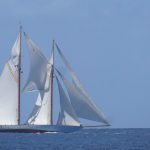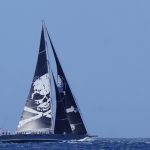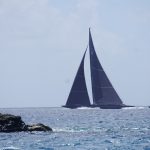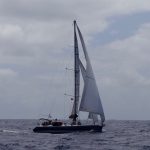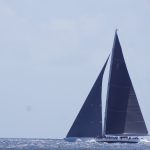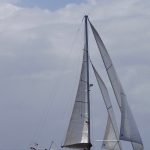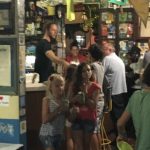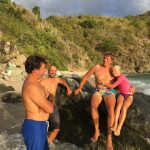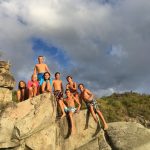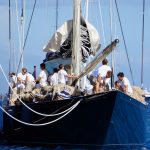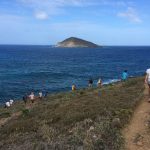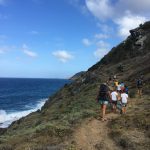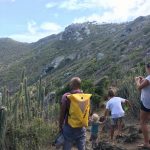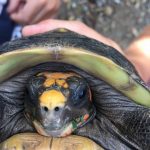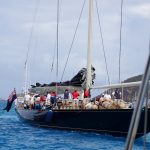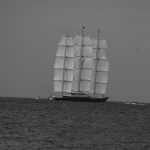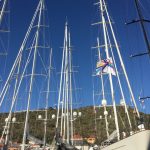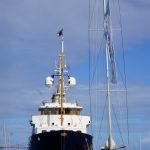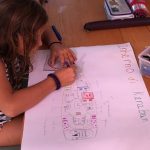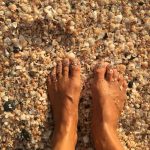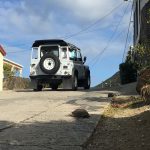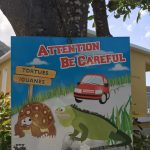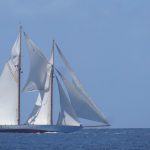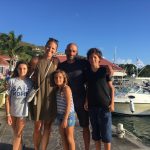We left Barbuda with a feeling that the moment is going to stay with us for a long time.
As we sailed out, we remembered there had been some hints as to the risks of the “incompletely surveyed” area, and the first couple of miles were completed with 2 crew at the bow.
It was a mild breeze, maybe 15-17 knots, and very deep, eventually beckoning a poled out genoa. From Barbuda to the BVI’s it is going to stay that way as we sail almost due West. I rather not think about the way back from BVI to St. Marteen in about a month time, from where the family will fly back and I will prepare Keraban for our second ocean passage with a very nice crew….did I say a month? Strange feeling.
We sailed, three masts in unison towards Gustavia some 25 nm away.
By now you should know who discovered St. Barthélémy, and the island was named after the discoverer’s younger brother. The Spanish however dismissed the Island as it had no resources, and so had done the Caribs (no fresh water), and it was not until the 1600s that the French established a settlement made mostly of Bretons and Normands, which until today make up most of the population of 6,000. The place has developed around its harbor and shipyard activity, as there are no natural resources to exploit (thence almost no slaves). The shipping expertise also attracted pirates, which also needed their equivalent to antifouling done now and then. A notorious pirate was Montbars, nicknamed the Exterminator after his ferocious attacks on Spanish ships. His treasures, hidden on St. Barth are yet to be discovered….
In one of the bizarre trades (or fantastic, depending on which side of the table you are sitting) that have sealed the destiny of many islands in the Antilles, in 1784 Louis XVI ceded St. Barth to his friend King Gustav III of Sweden (hence the capital’s name. Mind you, the French also exchanged Canada for Martinique) against an unknown quantity of merchandise and access to Gothenburg. The Swedes made of it a free port, benefitting from transit attracted by shelter in otherwise belligerent waters.
Taking a long step forward in time, Gustavia, already empoverished by the migration of the shipping community towards the Virgin Islands, was washed aground by hurricanes and a massive fire in 1852, only to be rebuilt in the 1960s. It was purchased back by France in 1877.
As we were sailing closer we discerned some very high masts with carbon – Kevlar and other exotic material moving unrealistically fast across the water. It seemed a regatta of super sailboats, and the race triangle was right on our path. Although maritime priority rights prevail, I suspected that the skipper of a J class at full tilt may have not appreciated, and we duly steered away. As we later discovered, this was the Bucket Regatta taking place. Useless to describe it, check the pics and you will understand that we felt small indeed.
Anchoring took a long time, and we threw the hook 4 times before setting for a spot at a half reasonable distance from neighboring boats.
Indeed, there were just hundreds of them at anchor outside Gustavia in spite of the roll, and the number of 50m+ masts was countless.
Our luck, we found a spot between a Cigale 18 from 1995 and a J Class laying by its tender boat, appropriately named Bystander (anywhere else, Bystander itself would be a prize winner for the most appealing trawler yacht). Watching the 30+ crew of a J Class getting ready in the morning barely 30 meters from us was special, and you’d wish they would invite you to be there, just once.
So the illustrious port of St. Barthélémy is mixture of Swedish ascendance and French presence, and known as a destination for the 1970s-80s jetset. Beware of à priori though, as is the case for many first-time visitors of Mustique: you will find a quiet mixture of well-heeled and bare-foot depending on what you are (looking for), and the fact that the entire island depends almost solely from sailors and related harbor acti vity contributes to the overall very welcoming setup.
Once clearance completed, by far the most efficient to date, we set foot onshore (they have something fancy they call computer and, even crazier, a printer. No carbon copies, imagine that. Also, you get your exit form filled automatically based on your previously saved entry form).
Neat streets bearing French and Swedish names, boutiques, restos, boulangeries and branded luxury good shops. Walking on paved streets surrounded by contemporary architecture was new to us since we had left the Canaries. Not saying positive or negative, but we did notice, especially coming from Barbuda.
In Gustavia one can also be found enjoying a beer and/or burger at the Select: the first bar to open (in the Caribbean?) in 1949, history of sailing in the Caribbean condensed between four walls of B&W pictures, handwritten letters and varied marine wear, full of crew from the Bucket Regatta and serving hamburgers with fries for eur7-10. We had a good time.
Dinghying back at night and making the long crossing of the bay you could be forgiven to think of it as Manhattan, with countless masts topped with a red light (meaning at least 50m), quite magic. Bouncing and getting wet in your dinghy in the choppy seas, with a warm meal in your stomach also falls under the account of magic.
Next morning, as the kids were at school (sometimes they just do work by themselves, and it is good to see them growing more responsible by the day) Isa and I were going to do some minor food restocking, as well as refueling the small outboard’s tanks. Interestingly a couple of “tenders” to the big boys out there were ahead of us at the only gas pump, and each needed between 300 and 600L of gasoline. 1h wait all in all to fill our 15L.
Our tour of St. Barthélémy included Anse du Colombier on the W tip of the Island. This is a relatively secluded anchorage with a nice beach at its head, much quieter than Gustavia (although we had visited the later at peak time). From there, the cheerful group of 8 adults and 11 kids (a fourth boat had joined for a couple of days) started a trek on the N coast until Baie de St. Jean, passing Petite Anse, Anse des Flamands and Anse de Cayes, stopping here and there to discuss with a turtle, make a bath in a natural pool or just fill your senses with the panorama. We stopped for a well-deserved rest chez Madame Rolande and, exceptionally, traded the Ti Punch for some fruit cocktails, just making sure we would be in good shape for the trek back. BTW, infra dittos (hawaianas) are good enough for the most arduous climbs, as we have well proven by now.
Next morning it was time to check the diving spot by the rocks at the entrance of Anse du Colombier. A manta ray, a shark and two large “tarpons” hidden in a cave (impressively large and ugly) amongst others were spotted in relatively shallow waters.
The other spot around of St. Barthélémy that is worth visiting is Ile Fourchue, NW of Gustavia, even more deserted than Anse du Colombier. It was a lunch stop, although well protected and fine for overnight, but the lady members of the crew were pushing for a dining night out at St. Barth. To their credit, we ended up at the Select to enjoy our drinks, burgers and good mood.
With that, we were ready to start sailing downwind towards St. Martin, which all of us considered rather a technical scale. Each with their own issues to solve / material to find, but all with a large food & drinks purchase to make as it is notoriously difficult to do so at the Virgin Islands


